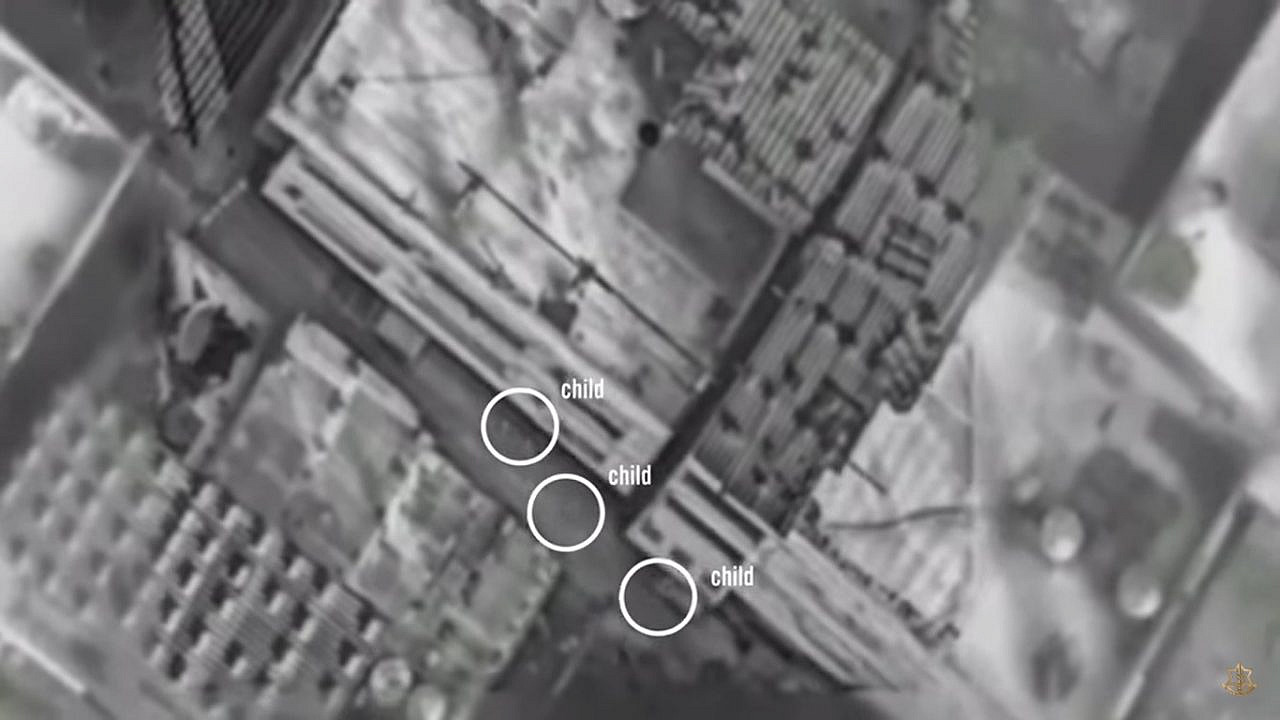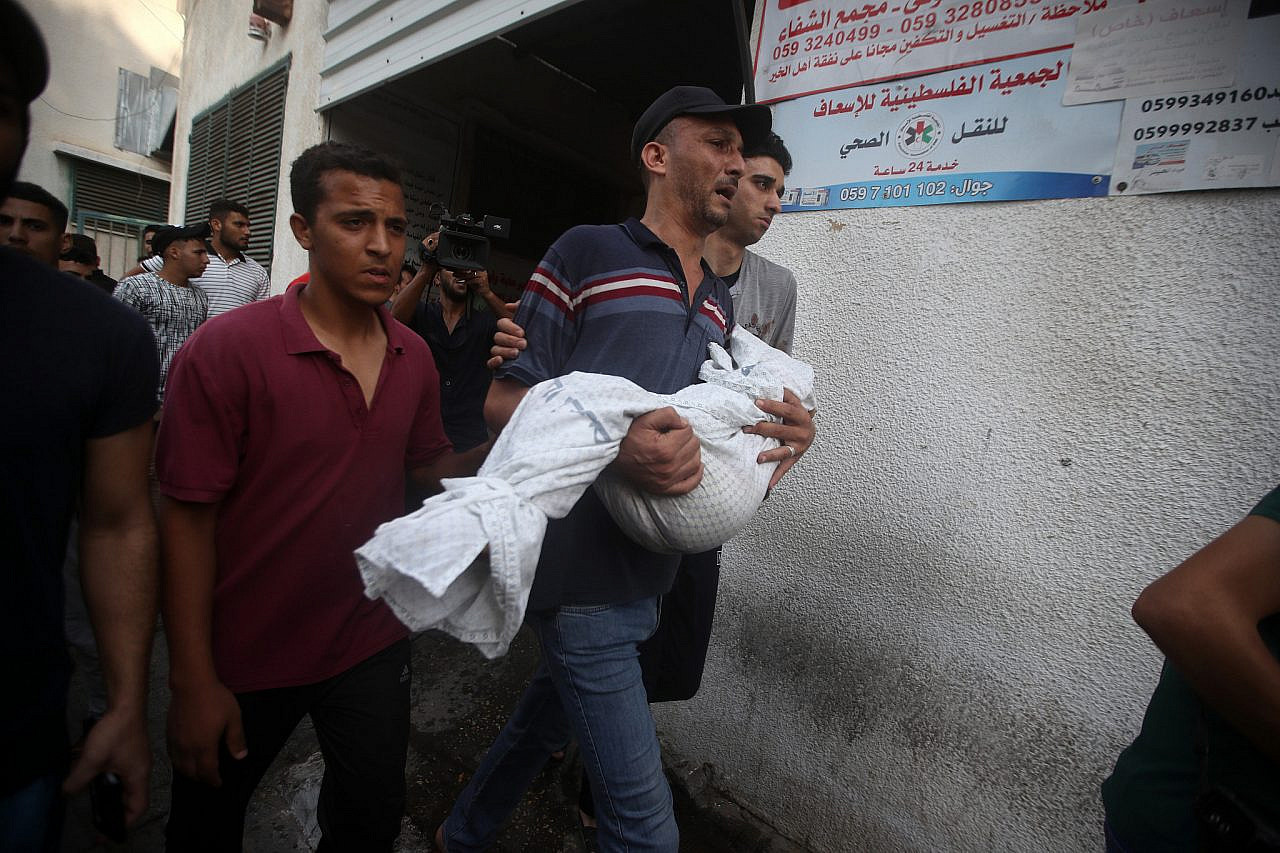On Sept. 4, the Israeli army launched a raid into the Jenin refugee camp for the first time since its large-scale invasion two months ago, as part of an operation to arrest several Hamas members. During an exchange of gunfire, the army deployed a Rafael SPIKE FireFly loitering munition — known as a “suicide” or “kamikaze” drone — to strike Palestinian militants in the area. The attack marked the latest use of combat drones in Jenin, signaling the machines’ increased presence in Israeli operations in the occupied West Bank.
The Israeli army has been using armed drones for decades to carry out, among other things, extrajudicial executions. But until last year, it was officially forbidden to publish this basic fact in the Israeli media; only on July 20, 2022, did the Israeli military censor change its policy. The longstanding media ban helped to stifle an informed public debate in Israel on the morality of these drones, even as such lively discussions were happening elsewhere in the world, especially around their use by the U.S. military.
A +972 and Local Call investigation reveals three cases — one of them during Operation Protective Edge in 2014, and two during Operation Guardian of the Walls in 2021 — in which nine Palestinian non-combatants, including five children, were killed as a result of missiles fired from drones. In one case, a criminal investigation was opened, but no one was prosecuted. In the other two cases, officers were reprimanded, but the army did not open an investigation.
An open secret
The Israeli army began using drones in the early 1980s in Lebanon before they were called “unmanned aerial vehicles” (UAVs), a name intended to imply a humane method of killing. In more recent years, the army has used these weapons to carry out thousands of attacks in the Gaza Strip, and most recently in Jenin.
For decades, these weapons were an “open secret,” with the whole world — and certainly Palestinians — knowing full well about the use of these weapons. Yet all the while, it was still technically prohibited to report on it to the Israeli public, even though they, too, knew that these weapons existed.

The Israeli Air Force itself boasted about attack drones in many of its publications (the IAF is not subject to the military censor, which often redacts or censors the publishing of what it considers sensitive material about the army’s activities in the Israeli press). In 2014, for example, the IAF magazine said that the Hermes 900 UAV, manufactured by the company Elbit Systems, “has an additional operational advantage over older aircraft, as it can carry multiple MTAs (dedicated cargo), allowing it to perform multiple missions in one sortie” (it did not state what that cargo was). In an official English video by the Defense Ministry for sales abroad, it was also shown how the Hermes 900 bombs its targets, emphasizing that its effectiveness has been proven in battle.
In 2022, Israel’s sales of these weapons comprised a quarter of all its defense exports, which peaked at $12.5 billion last year. Recently, in the wake of concerns about the impact of the judicial overhaul on Israel’s economy, Prime Minister Benjamin Netanyahu and Finance Minister Bezalel Smotrich claimed that the defense industry is “bursting with orders” for weapons, and that these exports would enable the government to keep its head above water economically.
The ties between the Israeli military and the private defense industry are so warm that the air force has shared videos hailing the wonders of Elbit’s drones. During the 2014 assault on Gaza, Israel rushed to “battle-test” Elbit’s Hermes 900 model, greatly facilitating sales of the aircraft.
For Palestinians in Gaza, the use of these drones is certainly no secret. Indeed, it is hard to find one resident of the strip who does not recognize the unique hum of these machines.
In early 2014, Atef Abu Saif, the Palestinian Authority’s culture minister and then a professor at Al-Azhar University in Gaza, published “Sleepless in Gaza,” a study analyzing the use of the aircraft against the strip’s residents since 2009. According to his findings, Israel carried out 42 drone attacks during 2008-9’s “Operation Cast Lead,” killing 87 people, including 29 children, and injuring a further 73 people. UAVs later killed 36 Palestinians during the 2012 assault on Gaza, two-thirds of whom were non-combatants.

Curbing public discussion
In the United States and elsewhere, the use of such weapons for extrajudicial executions has prompted moral and legal questions, including whether the cheapness of drone training and usage — compared to training and deploying a pilot — means that these machines are also employed excessively, thus cheapening the lives of those they kill. Moreover, what does it mean that the operators conducting drone strikes have almost no autonomy to decide the execution, except for the exact timing of the strike? And how many civilians are killed in these kinds of attacks?
The military censor’s ban on discussing these questions prevented this kind of moral discourse from taking place, while also stopping reporters from investigating the killing of civilians in drone strikes, whether by design or by accident. The Israeli public was thus effectively barred from questioning one of the military’s primary means of inflicting violence, especially on its occupied population.
Even after the censor lifted the prohibition a year ago, much of the Israeli media launched a preemptive campaign to curb public discussion on the use of UAVs in extrajudicial killings. Puff pieces celebrating the lifting of the censorship also extolled the virtues and aesthetics of the machines, while neglecting to discuss the numbers of the dead, the drone operators’ disconnection from their actions, and the morality of these weapons. The question of whether it is even appropriate to use these machines did not arise.
It is very possible that the lifting of the censorship is a trial balloon, at a time when drone use is rapidly accelerating. International media has reported that Israel has already begun deploying drones that make use of Elbit’s artificial intelligence (AI) software, Legion-X. In May 2021, Israel called its attack on Gaza “the world’s first AI war.”

A recent Bloomberg article revealed that the Israeli military also uses AI to select targets and “incriminate” them, using Israeli arms manufacturer Rafael’s Fire Factory software. Although there is human involvement in approving targets, they are chosen by algorithms considered a “black box” — meaning that whoever approves the attack cannot know what information led to the target’s criminalization.
The public silence after all this information has come to light is convenient for everyone involved. Arms companies get to publicize the benefits of using their drones without suffering criticism; the same goes for the Defense Ministry and the military, all but guaranteeing a transition to cheap, autonomous, and readily-available weapons. In the current political climate, with Israeli pilots refusing to conduct missions because of the judicial overhaul, using armed UAVs is especially appealing for the security establishment.
It is precisely for this reason that it is so dangerous for the Israeli public to leave the debate around drones to weapons manufacturers and generals behind closed doors.
A ‘flawless’ strike that killed four children
One of the most infamous incidents from Israel’s 2014 assault on Gaza was a strike that killed four Palestinian children on a beach. On July 16, 2014, not long after Israel’s military operation began, several children from the Bakr family, aged between 9 and 11, went out to play soccer by the sea, during a lull in attacks in the area.
At around 4 p.m., some of the children went into a shipping container on the beach, at which point they were attacked by a missile, which killed one of them. The surviving children ran away, and were struck by a second missile after moving away from the container.

Four children — Ahed Atef Bakr, 9, Zakaria Ahed Subhi Bakr, 10, Mohammed Ramez Izzat Bakr, 11, and Ismail Mohammed Subhi Bakr, 9, — lost their lives in the attack, and a further four from the same family were injured. According to the investigation, this was only one of “many hundreds” of such attacks.
Two drones were involved in the strike: one to photograph, and another to attack. According to an internal military police investigation, a Hermes 450 drone had been hovering four hours above the target, close to the beach. An Israeli naval intelligence officer, E., claimed that the container was recognized as belonging to a Hamas naval unit that had carried out an operation at a beach in southern Israel. E. explained that there was intelligence that a meeting of some Hamas force was supposed to take place there.
An army intelligence officer testified to the Military Police Criminal Investigation Division that the target had been investigated years before, and claimed that the fact that the children ran and then slowed to a walk was suspicious, because based on “previous experience,” combatants walked like that when they did not want to appear suspicious. The officer also said that in cases involving a senior target, it is possible to get permission to launch a strike that would also hit “uninvolved” civilians; here, however, no such authorization was given, meaning that the target on the Gaza beach was not defined as “senior.”
According to those who testified, the strike was “flawless,” and was based on strong intelligence equal to that of any other strike. The testifying officers said that if an alleged crime meets the plausibility test and that an attack is likely to kill hostile actors, then a strike is appropriate.
The evidence in the Bakr boys’ case points to an extreme incident of what is called a “signature strike,” wherein there is uncertainty about the exact identity of the targets, but their perceived pattern of behavior is enough to legitimize a strike. In the boys’ case, it was their entry into the shipping container — which had, years earlier, been identified as belonging to Hamas’ naval force — that was deemed sufficient for them to become targets. This assumption also guided the second strike seconds later, for which authorization was not sought — which, in the eyes of the army officers, was not unusual.

“I think the figures are Hamas naval commandos who are coming to collect equipment and perhaps leave on boats in preparation for an attack against the State of Israel,” testified a senior naval officer. The military had also wanted to “exact a price” from Hamas’ naval force for the infiltration at the Israeli beach several days prior, which is why the container was prioritized for an attack. In other words, the children killed in the strike were not identified as a “ticking bomb,” but were rather targeted in revenge for an operation carried out by Hamas.
Collateral damage
Given that, per the evidence, Israel had bombed the shipping container the day before, it is questionable whether Hamas fighters would have returned to the exact same spot a day later. It is also questionable whether, as it was claimed, the container was fenced off if it had been blown up a day earlier. No one who was interrogated for the investigation answered these questions.
One of the people who was questioned claimed that even after the footage from the first drone was examined a second time, it was not possible to know that the figures they could see were children. “It is very difficult to identify children because we’re looking at the area from a vertical perspective, from above,” they said.
M., an air force officer, said this attack received particular scrutiny because it was one of the first carried out with the Hermes 900 drone, which was first brought into service the day before the strikes on the beach. At that point, the army had no organized literature on how to operate drones in combat, and it would be several years before they were in regular use.
The army investigation into the Bakr boys’ deaths, as with all Israeli probes into the killings of civilians in the 2014 Gaza assault, was closed without a prosecution — despite the fact that the army’s own statistics showed that 369 Palestinian children were killed during the operation, most of them in air strikes. It is unknown how many of those deaths came from drone strikes.

In some cases, the army determined that the military advantage to be gained from killing the principal target outweighed the loss of civilian lives, whom it was known would be harmed when the attack was carried out. However, in conversations with Local Call, drone operators revealed that it is precisely these strikes — the ones where they know in advance they’ll be hitting non-combatants, rather than the ones involving mistakes — that exact the greatest mental toll.
The difference between “regular” and unmanned strikes is not just in the location of the soldier carrying out the attack, but also in the nature and number of targets. The crime is committed long before the killing actually happens, and almost no one in the chain of command, from the commander to the operator, has much discretion in the matter. Their autonomy is highly restricted because they get their information from other sources. They are often used as a human kosher stamp for killing.
A case of misidentification — and another one
Seven years later, during the May 2021 assault on Gaza, Israeli drone strikes killed five civilians in Gaza in two separate incidents.
According to a Local Call investigation, in the first, which took place on May 12, 2021, an IAF drone bombed a vehicle, killing four people who had been mistakenly identified as Hamas operatives. The Israeli army published footage of the attack. The victims — Aatef al-Barawi, Nael al-Barawi, Wael al-Ghawla, and Talaat Agha — were farmers who were loading peaches onto their vehicle in northern Gaza. The IDF Spokesperson confirmed to Local Call that the four were innocent; they were among 46 people killed in Gaza that day, half of whom were non-combatants.

The second incident occurred a week later, when 10-year-old Dima Asaliyah, a resident of Jabaliya, was killed in an unmanned air strike next to her home. She had apparently been misidentified as a Hamas operative. Her mother testified that Asaliyah had been sent to fetch a pot from her sister’s house, around 50 yards from their home, when the missile struck. As far as is known, there were no Hamas targets around her. Disciplinary action was taken against the officers, but no criminal investigation was launched.
Drones were also reportedly used in the military operation in Jenin refugee camp in July, an especially dense environment. However, the Israeli public — left almost entirely in the dark about the nature of the attacks — were again numb to the attacks, and no one questioned the ethics of using these machines. Few even asked about the point of these repeated rounds, or whether the widespread killing would merely provide fuel for the next flare-up.
As far as the Israeli army and the media are concerned, deterrence has been restored, and drone exports will continue to soar. But as we stand at the threshold of an era of fully automated killing, we must have this conversation — not only in the name of the Palestinians killed and wounded in drone strikes, but also because of its impact on Israeli society and the potential for these tools to serve an increasingly authoritarian regime.
Most read on +972
In response to a request for comment, the IDF Spokesperson said: “The IDF thoroughly investigates allegations of harm to those not involved [in fighting]. In the meantime, the IDF draws lessons from its operational activities on an ongoing basis, and integrates them into training and combat procedures, including in order to minimize harm to uninvolved [persons] and to become more operationally efficient.
“Since Operation ‘Protective Edge,’ the IDF has improved its observation and intelligence-gathering capabilities, and made adjustments to its methods of criminalizing targets, with the aim of reducing as much as possible harm to uninvolved [persons] during attacks on terror organizations operating in populated areas, as is evident from the operations in the Gaza Strip that took place over the last few years.”
A version of this article was first published in Hebrew on Local Call. Read it here.





